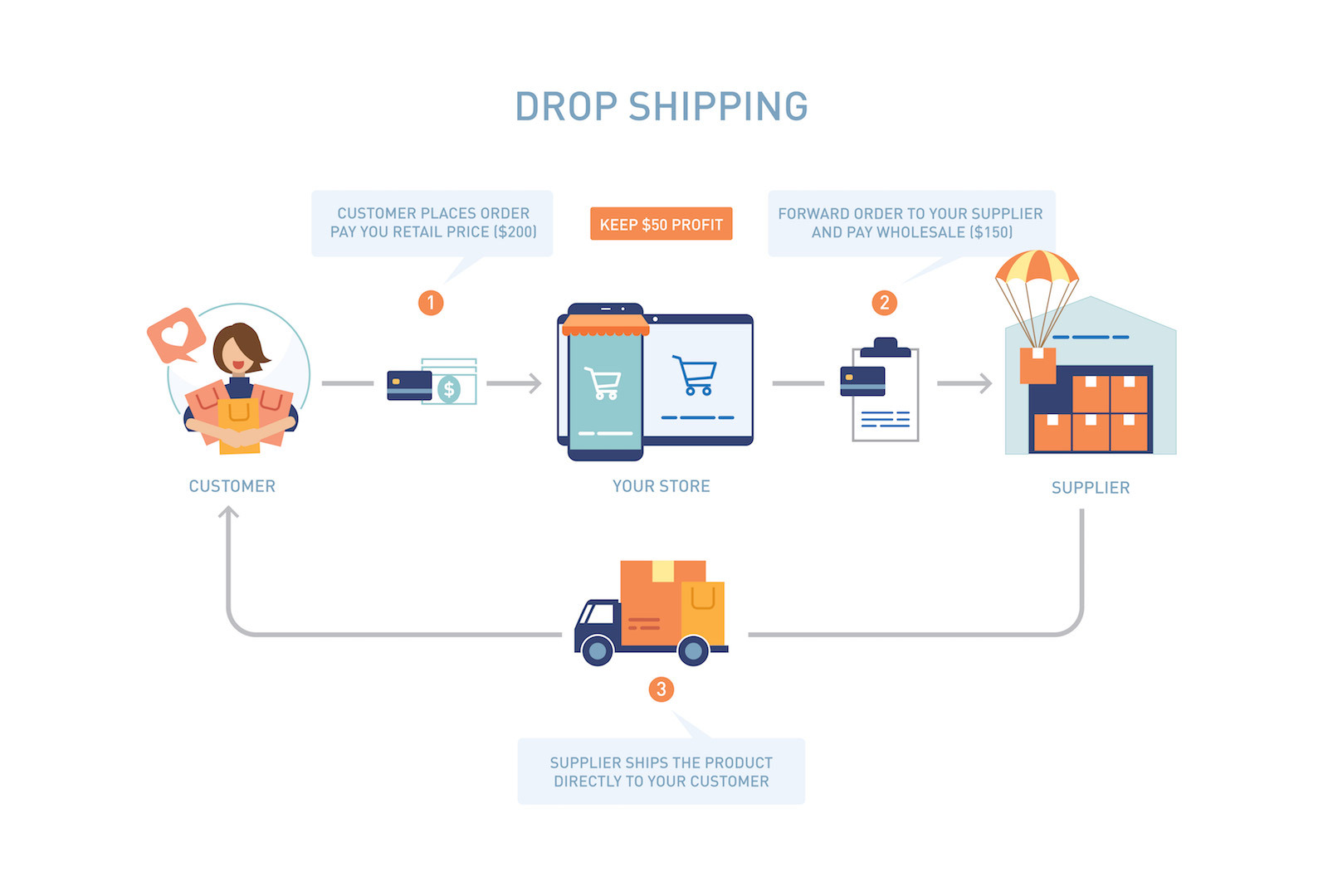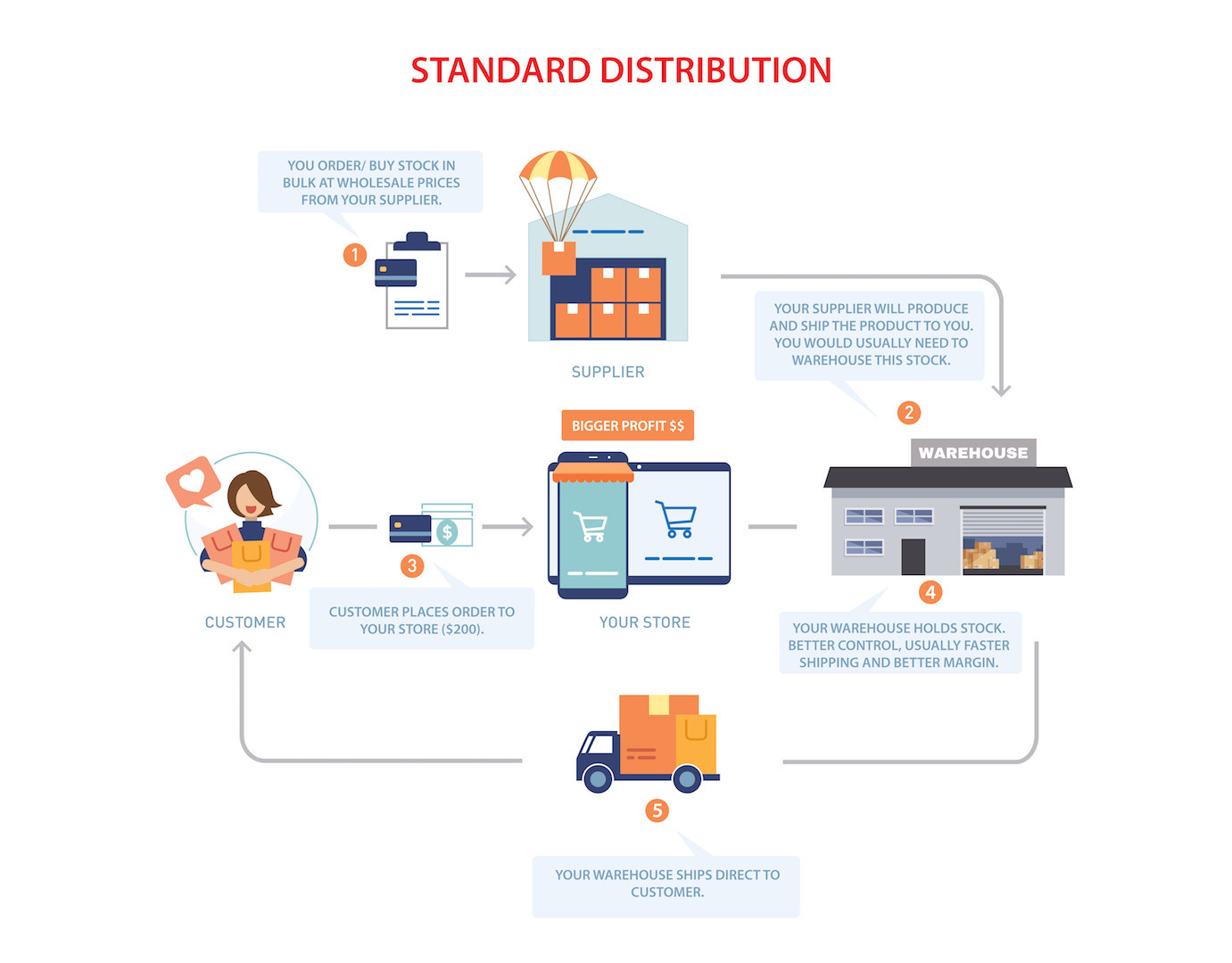Businesses across the world are enhancing their revenue by buying goods affordably from global manufacturing hubs like China and selling them in their own domestic market for a significantly higher price. The result: considerable profit.
There are two main ways sellers can achieve this: drop shipping or importing.
Both of these methods are very popular, and each bring with them their own benefits. So what works better for your business? Below, we’ll look at each of these sale techniques in detail and analyse their differences.
By the end of this article, we hope you have a better understanding of which approach is best for your operations.
What is drop shipping?
Drop shipping refers to creating an online store, where you sell products that other people manufacture and which you don’t yourself keep in stock.
Somebody buys your product online, and you then pay a supplier who offers drop shipping to ship the goods to your customer.
In a nutshell, all you have to do is:
- Locate a supplier that offers drop-shipping;
- Create a website to sell products;
- Choose the products your supplier is offering and place them on your site;
- Charge higher for the goods so you make a profit;
- Pay your supplier once somebody buys your product; and
- Your supplier will ship directly to your customer.

What is importing?
Most businesses are importers – in the United States alone, 85.6% of all imported goods in 2018 were imported by U.S. businesses.
Put simply, you buy a lot of goods in bulk at a ‘wholesale’ price (i.e. a very cheap price), and then sell them in your domestic market at whatever the market rate is.
It’s hugely profitable, and very popular on online retailers such as eBay and Amazon.
In a nutshell, importing works as follows:
- Find a great supplier for a product;
- Buy large amounts from them;
- Your suppler will ship those products to you; and
- You sell them to your customers at the market price.

There are obvious differences in the processes of both drop shipping and importing. But let’s take a closer look at the whole picture, so you can decide which option is best for you.
Ease
When it comes to comparing the two, drop shipping wins when it comes to ease. It is far less time consuming as you don’t handle any of the logistics (meaning you can spend more time on marketing and business development). You could even run a drop shipping business from home.
You also have very little start-up costs (just paying for a website) or overhead costs.
With importing, by contrast, you’ll need to worry about:
· Maintaining (and paying for) a warehouse;
· Packing and shipping;
· Tracking your inventory;
· Handling any returns; and
· Managing your stock/inventory level.
You don’t have to worry about any of this with drop shipping.
Also, generally, you can add on as much profit as you like when drop shipping your products through your website (although, as we’ll see below, those margins are thin).
Control
Drop shippers have zero control over when their goods will ship (if they’re shipped at all). There’s always a risk of a supplier simply taking your money and running away.
You won’t actually know your goods haven’t shipped until your customer starts filling out the ‘complaint’ form on your website.
Further, as a drop shipper, you will be completely subject to your supplier’s ups and downs. If their service is disrupted (such as during the Chinese New Year period), you will be blamed – not your supplier. Take a look at the United Kingdom, where Brexit is reportedly having a significant negative effect on the domestic drop shipping industry.
You’ll also have absolutely no idea when an item is out of stock or not. This is especially important if you’re sourcing from different warehouses, whose inventory can change almost daily. Just take a look at the Australian case of Ozdirect, whose drop shipping business was successfully sued for misleading and deceptive conduct after displaying outdated inventory lists on their website.
Quality of goods
As a drop shipper, you may never actually see the product you’re selling in real life. Your customers may receive faulty, damaged or defective products and you’d have no idea.
That’s because you have no control over the quality of the goods you’re selling. You’ll have no opportunity to check the product for yourself and verify if it’s up to an appropriate standard.
Delivery speed
Drop shipping from places like China will normally take anywhere between 2 and 6 weeks from the date of purchase to your customer’s receipt. Your buyers may get worried and – worse – they may come to you demanding to know what’s going on. They may even ask for their money back.
When you’re importing, you will have more control over your goods including complete control of when your goods will actually ship out to your customer.
Operating costs
Drop shipping has very minimal operating costs but importing does unfortunately come with those unavoidable operating costs.
These costs include things like packing and shipping (whereas with drop shipping, a supplier will often ship for nothing) and storage fees (you need a place to store all your goods!)
Profit margins
Despite the very limited operating costs of drop shipping, it does have fewer profit margins compared with importing.
The logic for this is very simple – when you buy a product via drop shipping, you pay either the market price or just below for that good because you are buying products one at a time.
Suppliers will be unwilling to give you a ‘drop shipping discount’ as opposed to your traditional wholesale discounts when buying in bulk.
But when you’re importing, you’re buying a bulk of goods at a wholesale price. This means when you sell your goods at a retail price, the profits are actually much higher.
Branding
When importing goods, you can build a personal and unique brand by adding your own logo to your products.
This option is not typically available with drop shipping, where suppliers will have most of the control over the product.
Also read: China, India or Vietnam: Where Should You Source & Manufacture?
Can I sell to drop shippers?
Despite the risks of drop shipping, there are opportunities to work with other people who have decided to adopt the drop shipping model.
We’ve recently seen a growth in businesses making their own stock and selling that stock on to drop shippers.
This is an excellent opportunity for a growing business because:
· You deal with one central and regular drop shipping ‘customer’, as opposed to numerous ‘regular’ customers which may be all over the world;
· You maintain higher profit margins than you would through adopting a drop shipping model yourself; and
· You keep in control of your own inventory.
Need help with handling your shipment?
We’re the experts in drop shipping and importing here at The Sourcing Co. As a leading sourcing company across the Asia Pacific, we can help businesses all around the world navigate the complex world of international trade.
With offices in China, Vietnam and Australia, and with key partnerships with suppliers in Indonesia, China and Vietnam, we cover a broad geographical area from which we’ve acquired a wealth of experience.
Please get in contact with our friendly staff today to start discussing your shipping options.
